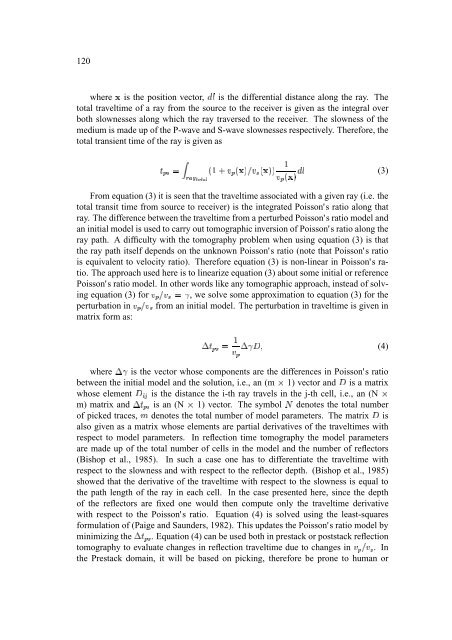Annual Report 2000 - WIT
Annual Report 2000 - WIT
Annual Report 2000 - WIT
You also want an ePaper? Increase the reach of your titles
YUMPU automatically turns print PDFs into web optimized ePapers that Google loves.
€<br />
b<br />
b<br />
120<br />
S where is the position s vector, is the differential distance along the ray. The<br />
total traveltime of a ray from the source to the receiver is given as the integral over<br />
both slownesses along which the ray traversed to the receiver. The slowness of the<br />
medium is made up of the P-wave and S-wave slownesses respectively. Therefore, the<br />
total transient time of the ray is given as<br />
&jf M S<br />
O.i)&)h M S<br />
(3)<br />
k fjhtumv7wFxFyYz{y<br />
O.O<br />
p7| M<br />
O)s<br />
r<br />
M &gf<br />
rA}<br />
S<br />
From equation (3) it is seen that the traveltime associated with a given ray (i.e. the<br />
total transit time from source to receiver) is the integrated Poisson's ratio along that<br />
ray. The difference between the traveltime from a perturbed Poisson's ratio model and<br />
an initial model is used to carry out tomographic inversion of Poisson's ratio along the<br />
ray path. A difficulty with the tomography problem when using equation (3) is that<br />
the ray path itself depends on the unknown Poisson's ratio (note that Poisson's ratio<br />
is equivalent to velocity ratio). Therefore equation (3) is non-linear in Poisson's ratio.<br />
The approach used here is to linearize equation (3) about some initial or reference<br />
Poisson's ratio model. In other words like any tomographic approach, instead of solving<br />
equation (3) for , we solve some approximation to equation (3) for the<br />
perturbation in from an initial model. The perturbation in traveltime is given in<br />
matrix form as:<br />
&jf0i)&)h &jf0i)&)hl~<br />
k fjh <br />
€ ~ƒ‚<br />
E (4)<br />
&jf r<br />
where is the vector whose components are the differences in Poisson's ratio<br />
~<br />
between the initial model and the solution, i.e., € an (m 1) vector and is a V matrix<br />
whose element is the distance the i-th ray travels in the j-th cell, i.e., an (N ‚ V<br />
m) matrix and ‚ fjh<br />
is an (N<br />
5…„<br />
1) vector. The symbol † denotes the total number<br />
V k<br />
of € picked traces, denotes the total number of model parameters. The matrix c is<br />
also given as a matrix whose elements are partial derivatives of the traveltimes with<br />
respect to model parameters. In reflection time tomography the model parameters<br />
‚<br />
are made up of the total number of cells in the model and the number of reflectors<br />
(Bishop et al., 1985). In such a case one has to differentiate the traveltime with<br />
respect to the slowness and with respect to the reflector depth. (Bishop et al., 1985)<br />
showed that the derivative of the traveltime with respect to the slowness is equal to<br />
the path length of the ray in each cell. In the case presented here, since the depth<br />
of the reflectors are fixed one would then compute only the traveltime derivative<br />
with respect to the Poisson's ratio.<br />
Equation (4) is solved using the least-squares<br />
formulation of (Paige and Saunders, 1982). This updates the Poisson's ratio model by<br />
minimizing the ‡PˆŠ‰j‹ . Equation (4) can be used both in prestack or poststack reflection<br />
tomography to evaluate changes in reflection traveltime due to changes in Œj‰0)Œ)‹ . In<br />
the Prestack domain, it will be based on picking, therefore be prone to human or







